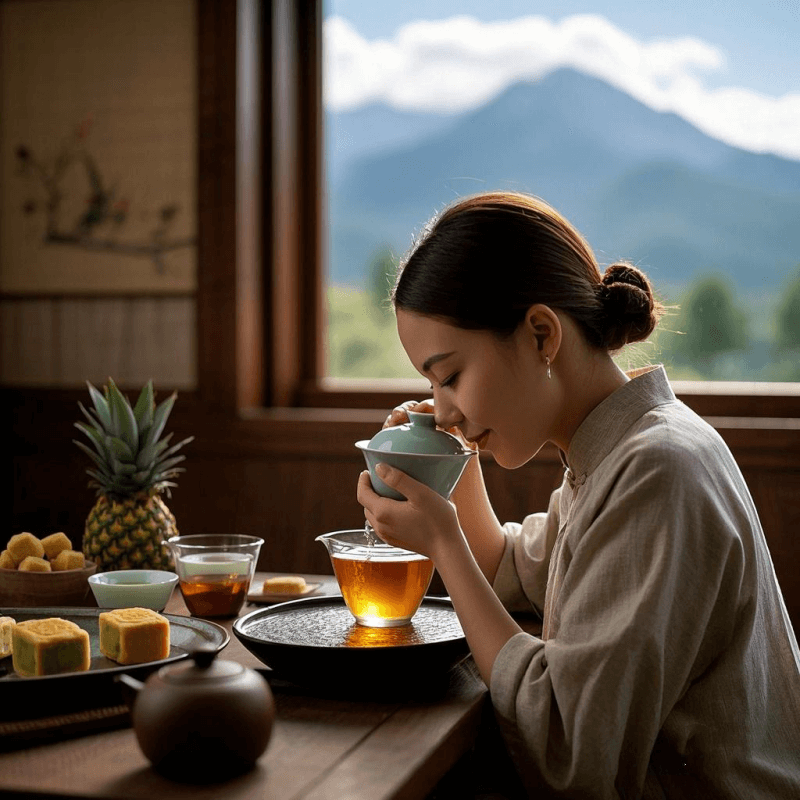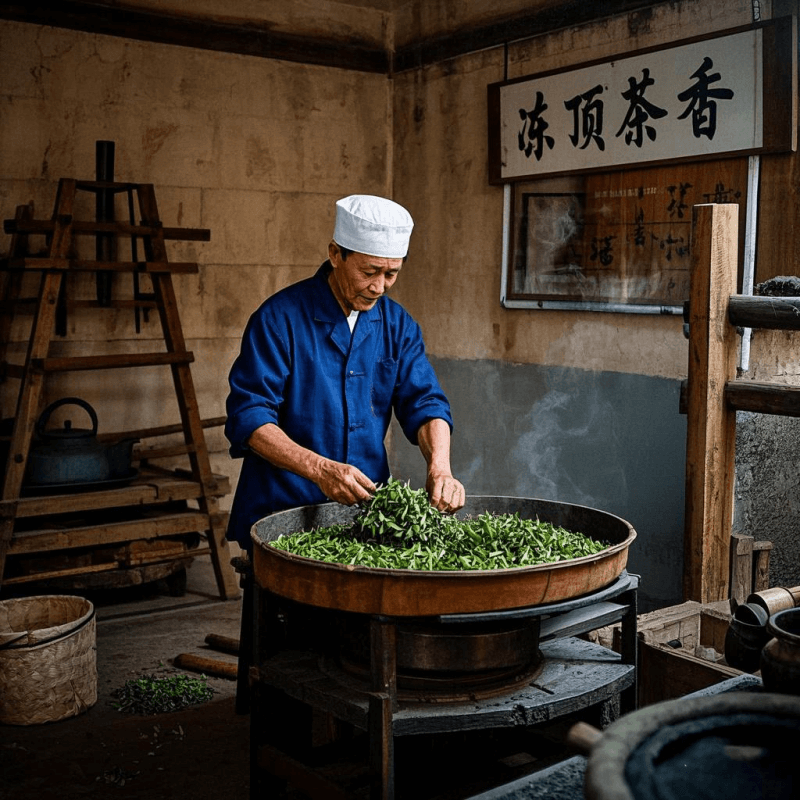
Nestled amidst the misty peaks of Taiwan, Dong Ding oolong tea stands as a testament to the island’s rich tea heritage and unparalleled craftsmanship. Revered as one of the most iconic semi – fermented brews, this mountain – grown tea has captured the hearts of tea enthusiasts worldwide with its complex flavor profile, enchanting aroma, and deep cultural significance. In this guide, we’ll embark on a journey to uncover the secrets of Dong Ding oolong tea, from its storied origins to its health benefits, brewing techniques, and more.
1. Introduction: Why Dong Ding Oolong Tea Is Taiwan’s Gem
Taiwan is renowned for its exceptional tea offerings, and Dong Ding oolong tea holds a special place among them. Named after the “Frozen Peak” (Dong Ding) mountain in Nantou County where it originated, this tea has become a symbol of Taiwanese tea culture. But what makes it so beloved?
For starters, Dong Ding oolong tea offers a unique balance of flavors that sets it apart from other varieties. Its production in high – altitude regions, where cooler temperatures and abundant mist slow down the growth of tea leaves, results in a concentrated flavor profile. The careful craftsmanship involved in its processing further enhances its complexity, creating a tea that is both smooth and full – bodied.
Moreover, Dong Ding oolong tea is deeply intertwined with Taiwanese culture. It’s a staple in traditional tea ceremonies, a cherished gift for special occasions, and a source of pride for local tea farmers. As tea expert Chen Mei – ling puts it, “Drinking Dong Ding oolong tea is like taking a sip of Taiwan’s soul. It’s a sensory experience that connects you to the land, the people, and the centuries – old tradition of tea – making.”
2. What Is Dong Ding Tea? Origins and Cultural Significance
The story of Dong Ding oolong tea dates back to the 19th century. According to legend, a tea farmer named Lin Feng – chiao traveled to Fujian, China, the birthplace of this semi – fermented brew, to learn the art of tea cultivation and processing. Upon returning to Taiwan, he planted the tea bushes on the slopes of Dong Ding Mountain, where the unique climate and soil conditions proved ideal for growing high – quality tea.
Over time, the reputation of Dong Ding oolong tea spread far and wide, earning accolades both locally and internationally. Its name, “Dong Ding,” which translates to “Frozen Peak,” refers to the mountain’s cool climate and the way the mist often lingers around its peak, giving the appearance of frost.
Culturally, Dong Ding oolong tea is more than just a beverage. It’s a medium through which Taiwanese people express their hospitality, celebrate traditions, and connect with their roots. In Taiwanese households, offering a cup of Dong Ding oolong tea to guests is a sign of respect and warmth. It’s also a common gift during festivals and important events, symbolizing good fortune and prosperity.
For a deeper dive into the origins and cultural significance of Dong Ding oolong tea, you can explore resources on Tea from Taiwan, a website dedicated to promoting Taiwanese tea.
3. Unique Flavor Profile of Dong Ding Oolong Tea

One of the most captivating aspects of Dong Ding oolong tea is its complex and nuanced flavor profile. This mountain – grown tea typically offers a harmonious blend of floral, fruity, and roasted notes, creating a multi – dimensional taste experience.
Aroma
- Dry Leaves: The unbrewed leaves of Dong Ding oolong tea emit a rich, warm aroma with hints of toasted nuts, caramel, and a subtle floral undertone.
- Brewed Tea: Once steeped, the tea releases a more pronounced aroma that combines the sweetness of ripe fruits, such as apricots and peaches, with the delicate fragrance of orchids and jasmine. There’s also a lingering roasted scent that adds depth and complexity.
Taste
- Initial Sip: The first taste is often characterized by a smooth, creamy texture that coats the palate. There’s a gentle sweetness that balances the mild astringency, creating a refreshing and inviting flavor.
- Mid – Palate: As you continue to sip, the flavors evolve, revealing more pronounced notes of roasted chestnut, honey, and a touch of spice. The combination of these flavors gives the tea a full – bodied and satisfying taste.
- Aftertaste: Dong Ding oolong tea leaves a long – lasting, sweet aftertaste that lingers on the tongue, leaving you craving another sip.
The flavor profile of Dong Ding oolong tea can vary depending on factors such as the altitude of the tea gardens, the season of harvest, and the specific processing methods used. Some versions may have a more pronounced floral character, while others may emphasize the roasted notes.
4. How Dong Ding Is Grown and Processed
The cultivation and processing of Dong Ding oolong tea are meticulous processes that require skill, patience, and a deep understanding of the tea plant.
Growing Conditions
- Altitude: Dong Ding oolong tea is primarily grown at elevations between 600 and 1,000 meters above sea level. The cooler temperatures at these heights slow down the growth of the tea leaves, allowing them to develop a higher concentration of flavor compounds.
- Climate: The region experiences abundant rainfall and frequent mist, which provide the ideal humidity levels for tea cultivation. The mist also helps to protect the tea plants from direct sunlight, preventing the leaves from becoming too bitter.
- Soil: The soil on Dong Ding Mountain is rich in minerals and organic matter, which contribute to the unique flavor of the tea.
Processing Steps
- Harvesting: The tea leaves are handpicked during the spring and winter seasons, when they are at their peak quality. Only the youngest and most tender leaves and buds are selected.
- Sun – Wilting: After harvesting, the leaves are spread out in the sun for a short period to remove some of the moisture and activate the enzymes in the leaves.
- Indoor Wilting and Oxidation: The leaves are then moved indoors and left to wilt further. During this stage, the leaves are gently tossed to promote oxidation, which gives this semi – fermented tea its characteristic flavor. The degree of oxidation for Dong Ding oolong tea typically ranges from 30% to 50%.
- Rolling: The oxidized leaves are rolled into tight curls to break the cell walls and release the inner juices, which help to develop the tea’s flavor and aroma.
- Baking: The rolled leaves are baked at a low temperature to remove any remaining moisture and enhance the roasted flavor. This step also helps to stabilize the tea and extend its shelf life.
- Sorting and Packaging: Finally, the tea is sorted to remove any impurities and packaged for distribution.
5. Health Benefits of Drinking Dong Ding Oolong Tea
Like other Taiwanese oolong varieties, Dong Ding oolong tea offers a range of potential health benefits, thanks to its rich content of antioxidants, polyphenols, and other bioactive compounds.
Antioxidant Protection
- Dong Ding oolong tea is packed with antioxidants, such as catechins and theaflavins, which help to neutralize free radicals in the body. Free radicals are unstable molecules that can cause cell damage and contribute to the development of chronic diseases, including cancer, heart disease, and Alzheimer’s disease. By consuming Dong Ding oolong tea, you can help to protect your cells from oxidative stress and reduce your risk of these diseases.
Weight Management
- Some studies suggest that the compounds in this semi – fermented tea, including those in Dong Ding oolong tea, may help to boost metabolism and increase fat burning. Caffeine and certain polyphenols in the tea can stimulate the body’s thermogenesis process, which is the production of heat in the body that helps to burn calories. Additionally, this tea may help to reduce appetite, making it easier to control calorie intake.
Heart Health
- Regular consumption of Dong Ding oolong tea may have a positive impact on heart health. The antioxidants in the tea can help to lower cholesterol levels, reduce blood pressure, and improve blood vessel function. By promoting a healthy cardiovascular system, Dong Ding oolong tea can help to reduce the risk of heart disease and stroke.
Digestive Health
- Dong Ding oolong tea can also aid in digestion. The tea’s mild caffeine content can stimulate the digestive system, promoting the movement of food through the intestines and preventing constipation. Additionally, the polyphenols in the tea may help to regulate the growth of beneficial bacteria in the gut, improving overall digestive health.
6. How to Brew Dong Ding Tea the Right Way
Brewing Dong Ding oolong tea correctly is essential to unlock its full flavor potential. Here’s a step – by – step guide to help you brew the perfect cup:
Tools and Ingredients
- Teaware: A gaiwan or a small porcelain teapot is ideal for brewing Dong Ding oolong tea. These types of teaware help to retain the tea’s aroma and flavor. You’ll also need a tea strainer, a fair cup, and small tea cups.
- Water: Use filtered or spring water for the best results. Avoid using tap water, as it may contain impurities that can affect the taste of the tea.
- Tea Leaves: Use 5–7 grams (about 1–1.5 teaspoons) of Dong Ding oolong tea leaves per 150–200 milliliters (about 5–7 ounces) of water.
Brewing Steps
- Preheat the Teaware: Pour hot water into the gaiwan or teapot, the tea cups, and the fair cup. Swirl the water around and then discard it. This helps to warm the teaware and enhance the tea’s flavor.
- Add the Tea Leaves: Place the tea leaves into the preheated gaiwan or teapot.
- Rinse the Tea Leaves: Pour hot water (around 90–95°C or 194–203°F) over the tea leaves and immediately pour it out. This step, known as “washing the tea,” helps to remove any dust or impurities from the leaves and wakes them up, preparing them for brewing.
- First Steep: Pour hot water over the rinsed tea leaves and let them steep for 20–30 seconds. The exact steeping time may vary depending on your taste preferences and the quality of the tea.
- Pour the Tea: Use the tea strainer to pour the brewed tea into the fair cup. This helps to separate the tea leaves from the liquid and ensures a clear, smooth cup of tea.
- Serve the Tea: Pour the tea from the fair cup into the tea cups and serve immediately.
- Subsequent Steeps: Dong Ding oolong tea can be steeped multiple times. For each subsequent steep, increase the steeping time by 10–15 seconds. You can typically steep the tea 5–7 times, with each steep offering a slightly different flavor profile.
To truly elevate your tea experience, [discover the subtle beauty of this semi – fermented tea with our premium leaves](https://yiheteas.com/product/oolong – tea/) and [elevate your tea experience with authentic teaware](https://yiheteas.com/product/oolong – tea/). And if you’re looking to explore more options, [browse our tea collection for every taste preference](https://yiheteas.com/product/oolong – tea/) and [savor the taste of this tea with traditional brewing tools](https://yiheteas.com/product/oolong – tea/).
7. Conclusion: Savor the Elegance of Dong Ding in Every Sip
Dong Ding oolong tea is more than just a beverage; it’s a journey through Taiwan’s natural beauty, cultural heritage, and tea – making traditions. From its humble beginnings on the slopes of Dong Ding Mountain to its status as a globally recognized tea variety, this mountain – grown brew continues to captivate tea lovers with its unique flavor, enchanting aroma, and numerous health benefits.
Whether you’re a seasoned tea connoisseur or new to the world of this semi – fermented tea, Dong Ding oolong tea offers a sensory experience like no other. So, the next time you’re looking to unwind, connect with culture, or simply enjoy a delicious cup of tea, reach for a tin of Dong Ding oolong tea and savor the elegance in every sip.

Pingback: Unlock the Flavor Secrets of High Mountain Oolong Tea: A Complete Guide